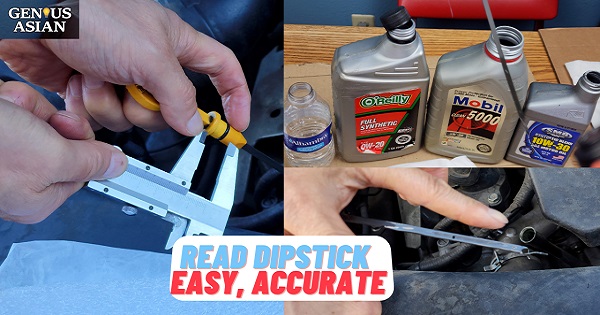https://youtu.be/asj9r5g8ePQ For some cars, reading the dipstick is difficult. There could be many reasons why it is hard to read and many people discuss this topic on the internet. There are three existing common solutions: some suggest drilling additional holes on the dipstick, some recommend cutting, or notching, the edge of the dipstick to capture oil, others encourage you to file surface the of the dipstick to roughen the surface assuming this would capture more oil than a smooth surface will. But all these existing solutions are creating permanent irreversible change to a car component. Not only is it uncertain whether the modification will work well under various different conditions, but also it may lead to unintended consequences. Why would your own modification be significantly better than that designed by experienced car manufacturers?
My solution is quite easy and simple, and it does not require any modification. It may take a few seconds longer to check the oil, but can be as precise as you wish.
Your vehicle’s dipstick should have holes, letters, or lines that help indicate the oil level in the engine.The lowest marking is closest to the tip of the dipstick, while the highest should be closer to the cap of the dipstick. So where should oil be on the dipstick? Those two holes or marks on the dipstick show the optimum level that your oil should be at. Your oil level should be somewhere between the two. if the oil is close to or below the markings at the end of the dipstick, or if there isn’t any oil on the dipstick at all, then you need to add some engine oil. If the oil is above the upper mark, you’ll need to drain it out to maintain a normal oil level.
Q: What does the H stand for on a dipstick?
The letter “H” on a dipstick stands for high or normal oil levels. The car dipsticks have holes or markings that depict optimal and worrisome oil levels. Depending on the car, the markings could be a set of pinholes that indicate MAX (for maximum) and MIN (for minimum). For some vehicles, you might find letters like H (High) and L(Low). Others use F(Full) and L(Low).
Chapters
0:00 some dipsticks are hard to read
0:20 thin oil 10W-30, 2W-20, 0W-20
0:53 oil 0W drips fast,
1:13 water can be caught in the Low hole
1:34 how to capture oil, the hole is the most important feature
2:05 step 1: check oil level same way as traditional
2L25 distance estimate needs to be generous
2:45 step 2: insert but stop short of distance
3:31 without cleaning dipstick, insert further each time
3:51 final distance indicates the oil level
4:19 my method easy to read, accurate,
4:39 Alternative method 1: drill holes on dipstick
5:01 Alternative method 2: cut dipstick edge
5:35 Alternative method 3: file dipstick surface
6:09 car modifications risks: irreversible, unintended consequences
6:33 other causes of reading dipstick difficult
6:54 cause 2. parked on slope; 3. stick rubs tube wall
7:19 4. dipstick reading asymmetry
7:40 when hot vs cold engine reading dipsticks
Since various cars have dipsticks which are harder or easier to read than others, please leave comments below on your experience with cars or dipsticks so that we can know more about where issues occur!
If you parked your car on a sloped driveway, check out our 4 Ways To Accurately Check Oil Level On Sloped Driveway, Any Inclined Ground, Hills Guaranteed https://youtu.be/SYmAJkPRmgQ

